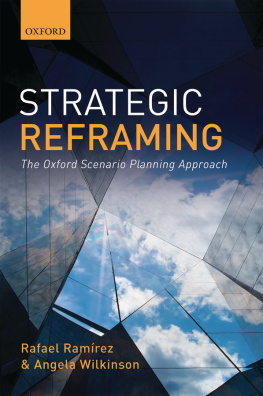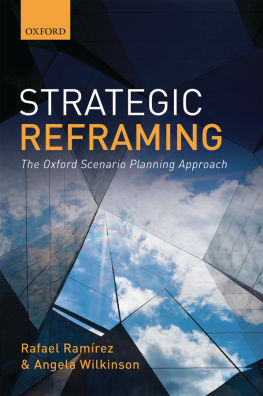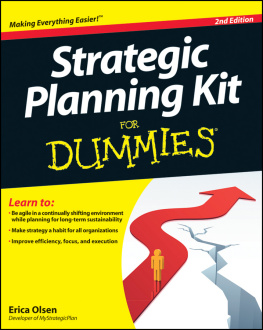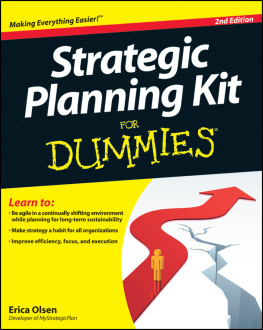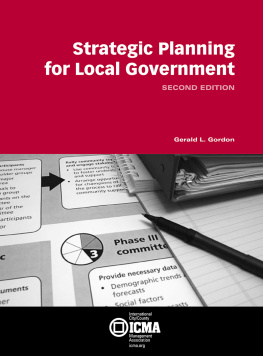Rafael Ramirez - Strategic reframing:The Oxford Scenario Planning Approach
Here you can read online Rafael Ramirez - Strategic reframing:The Oxford Scenario Planning Approach full text of the book (entire story) in english for free. Download pdf and epub, get meaning, cover and reviews about this ebook. year: 2016, publisher: OUP Oxford, genre: Romance novel. Description of the work, (preface) as well as reviews are available. Best literature library LitArk.com created for fans of good reading and offers a wide selection of genres:
Romance novel
Science fiction
Adventure
Detective
Science
History
Home and family
Prose
Art
Politics
Computer
Non-fiction
Religion
Business
Children
Humor
Choose a favorite category and find really read worthwhile books. Enjoy immersion in the world of imagination, feel the emotions of the characters or learn something new for yourself, make an fascinating discovery.
- Book:Strategic reframing:The Oxford Scenario Planning Approach
- Author:
- Publisher:OUP Oxford
- Genre:
- Year:2016
- Rating:5 / 5
- Favourites:Add to favourites
- Your mark:
- 100
- 1
- 2
- 3
- 4
- 5
Strategic reframing:The Oxford Scenario Planning Approach: summary, description and annotation
We offer to read an annotation, description, summary or preface (depends on what the author of the book "Strategic reframing:The Oxford Scenario Planning Approach" wrote himself). If you haven't found the necessary information about the book — write in the comments, we will try to find it.
Strategic reframing:The Oxford Scenario Planning Approach — read online for free the complete book (whole text) full work
Below is the text of the book, divided by pages. System saving the place of the last page read, allows you to conveniently read the book "Strategic reframing:The Oxford Scenario Planning Approach" online for free, without having to search again every time where you left off. Put a bookmark, and you can go to the page where you finished reading at any time.
Font size:
Interval:
Bookmark:


Great Clarendon Street, Oxford, OX2 6DP, United Kingdom
Oxford University Press is a department of the University of Oxford. It furthers the Universitys objective of excellence in research, scholarship, and education by publishing worldwide. Oxford is a registered trade mark of Oxford University Press in the UK and in certain other countries
Rafael Ramrez and Angela Wilkinson 2016
The moral rights of the authors have been asserted
First Edition published in 2016
Impression: 1
All rights reserved. No part of this publication may be reproduced, stored in a retrieval system, or transmitted, in any form or by any means, without the prior permission in writing of Oxford University Press, or as expressly permitted by law, by licence or under terms agreed with the appropriate reprographics rights organization. Enquiries concerning reproduction outside the scope of the above should be sent to the Rights Department, Oxford University Press, at the address above
You must not circulate this work in any other form and you must impose this same condition on any acquirer
Published in the United States of America by Oxford University Press 198 Madison Avenue, New York, NY 10016, United States of America
British Library Cataloguing in Publication Data
Data available
Library of Congress Control Number: 2015949018
ISBN 9780198745693
ebook ISBN 9780192507600
Printed in Great Britain by Clays Ltd, St Ives plc
Links to third party websites are provided by Oxford in good faith and for information only. Oxford disclaims any responsibility for the materials contained in any third party website referenced in this work.
We dedicate this book to our families: Genevive, Ivan, Louis, Noel, Ruairi, and Emer.
Why is this book important?
This is a book about strategic planning. Strategic planning is an approach to business planning aiming to be explicit about the value-creating principles that bring groups of people together in organisations to jointly pursue financial or other goals. The basis of the existence of organisations is the principle of economies of scale applied to production and transactions. This drives people together in order as a group to become more efficient in pursuing their shared aims. It leads to the need to organize things, driven by general management principles, which define goals and tasks to be performed to achieve the shared objectives. Under the influence of such driving forces emanating from general management things start to happen.
The organising and management activity becomes future oriented through an activity known as planning. Tasks are defined in advance and then allocated to people for execution. They become more articulate about achieving future goals, and so the future becomes important.
Management and planning have always been key ingredients of organisational life. The way planning was done, however, has changed significantly over the years in response to societal change in the business environment. For example, half a century ago planners based their activity on predicting the future and making forecasts. Of course one knew that making predictions is difficult and things could turn out quite differently from the plans. Even if over time, with increasing turbulence in the business environment the discrepancy between forecasts and reality increased. This was not seen as a reason to drop forecasting altogether, as long as it was perceived as assisting management to maintain some control over affairs. But as time passed by and uncertainty increased planners became concerned about how much of the future can really be known. We assume that something about the future must be knowable. Why otherwise educate the young? Or reward leaders disproportionately? But this knowledge is limited; and over the years planners became concerned about where this knowledge about the future stops.
A watershed was reached around the mid-1970s, following the first global oil/energy crisis. Here was a major event that was not on the radar screen of most people, including many of the planners. The reaction to this was the rapid and decisive development of what became known as strategic planning, in response to the growing awareness of the impossibility of forecasting this type of event. The reasoning of the strategic planners was as follows: if direct drivers such as demand and supply could not be predicted, but at the same time a total inability to predict anything would also not be a reasonable or useful assumption, then how might one engage the deeper driving forces underneath an apparently chaotic world of supply and demand at the macro-level? The answer of the strategic planners pointed to attending to these underlying value creation mechanisms.
Organisations were in the business of value creation driving demand. This was the traditional territory of economics which was now linked up with strategic planning. For example, Michael Porters framework was based on the principle of competitive advantage: if an organisation had competitive advantage demand would be attracted to it, and it would be successful, never mind what the rest of the market was doing.
Strategic planners became increasingly involved in refocusing their main attention from global demand statistics towards value creation. Attempts to articulate the principle of how any organisation (business or purpose driven) remains viable gave rise to notions such as the Business Idea as part of strategic planning (developed by R. Normann). Notions of this type proved helpful in describing the underlying success factors that lead to understanding successful performance. Strategic planning (and the strategic management that grew out of it) became based on understanding these principles.
Strategic management has been, and still is, in a state of flux. It is important to realize that its main focus of attention has been individual organisations and their competitive advantage considered from an economics perspective. Over time though, the field has expanded to bring into focus a much wider spectrum of stakeholders, moving the field towards an interest in the human perspective. The interest by many strategic planners in the socio-ecology field may be an outcome of that.
Strategic planning as it is practiced now would be unrecognisable to the planner of a half-century ago, involved in statistical aggregate demand at the macro-view. The last half-century has presented massive unprecedented change in the business environment, population has doubled, income quadrupled, and the Western world has seen no wars on its territories. So why is it that instead of making us feel increasingly confident that we are starting to understand organisations we actually feel less secure, change seems accelerating, control seems slipping out of our hands?
Some trends are obvious. For example, in global terms we are living closer and closer together, physically and informationally, highlighting cultural discrepancies with all the problems that come with it. Our ecological footprint now significantly exceeds available space and resource constraints are becoming evident. Beyond that there still are the great threats of our time. We are approaching the greatest discontinuity in history, Ian Morris suggests, driven by nuclear proliferation, population growth, global epidemics and climate change.
This is the contextual environment in which we need to develop our approach to planning. It is all new and unprecedented. The old way of strategic planning will not deliver on this massive task. This is turbulence territory. As explained later in this book this means that while the environment will be driven by these new global issues we will all increasingly experience the turbulent planning repercussions at our own individual level.
Font size:
Interval:
Bookmark:
Similar books «Strategic reframing:The Oxford Scenario Planning Approach»
Look at similar books to Strategic reframing:The Oxford Scenario Planning Approach. We have selected literature similar in name and meaning in the hope of providing readers with more options to find new, interesting, not yet read works.
Discussion, reviews of the book Strategic reframing:The Oxford Scenario Planning Approach and just readers' own opinions. Leave your comments, write what you think about the work, its meaning or the main characters. Specify what exactly you liked and what you didn't like, and why you think so.

